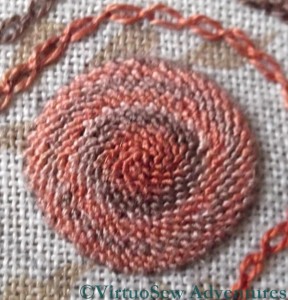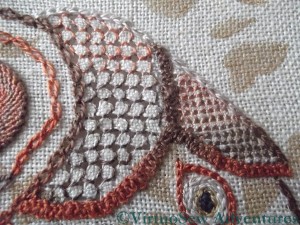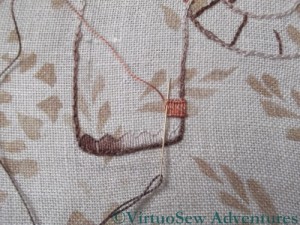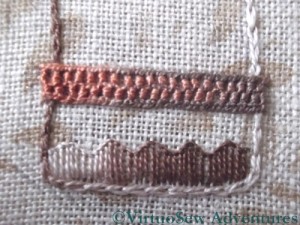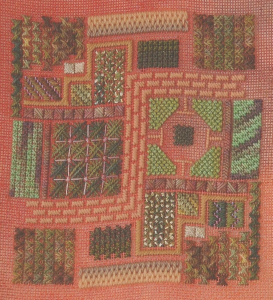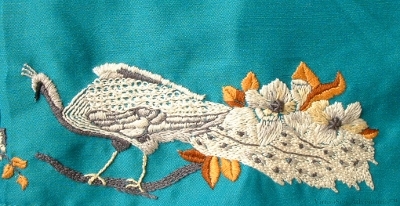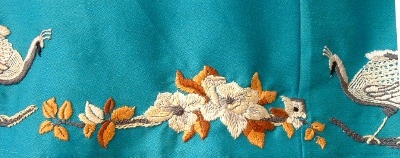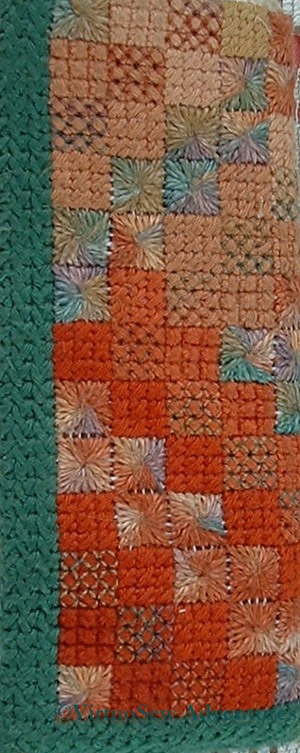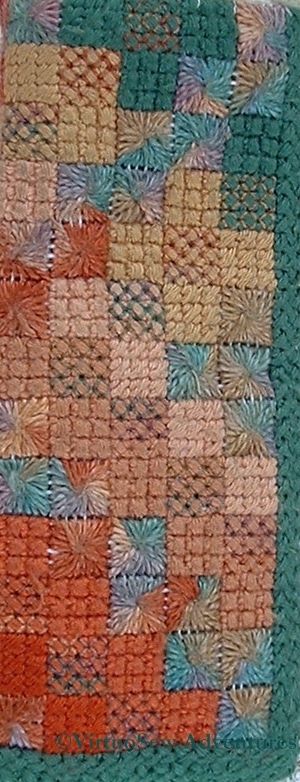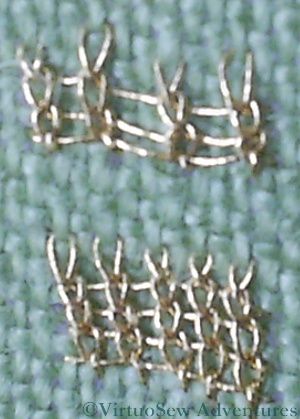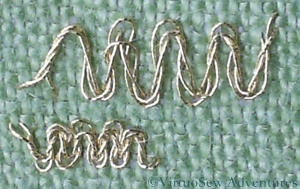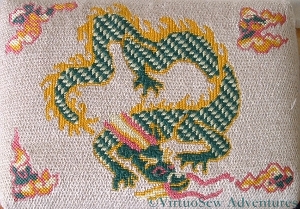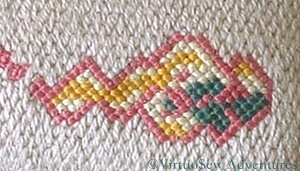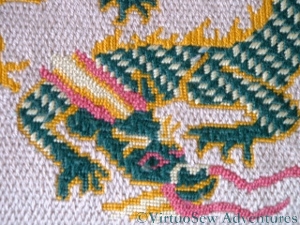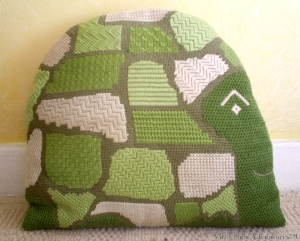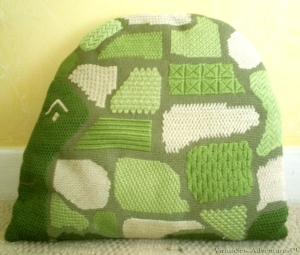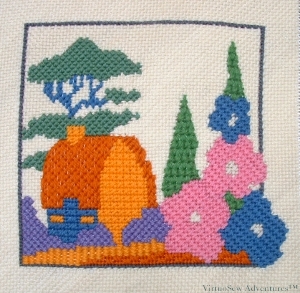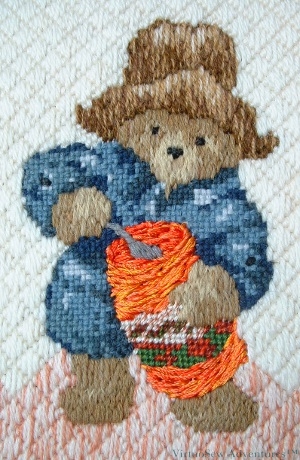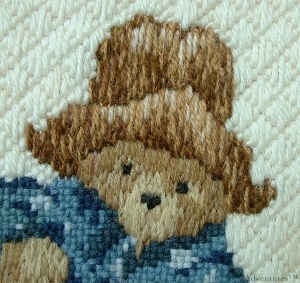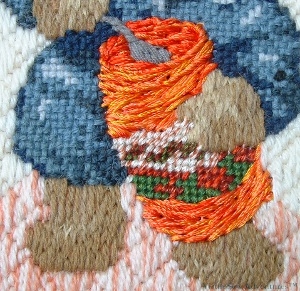Tag: ornamental stitches
Close-ups on the Elephant Doorstop
I’ve been asked to provide a few close ups from the Elephant Doorstop, so here goes.
This close-up shows the spiral trellis stitch medallion on the Elephant’s ear. I love this stitch – it creates a lovely nubbly texture! It’s about three quarters of an inch across.
The silk perlé I am using was in ready cut lengths, shading from orange to brown, and when I brought a new thread in, I started with the colour I’d just finished, so that the colour sections would be slightly longer and denser.
When I thought about working four-sided stitch on the Elephant’s headcloth, I was originally intending to work some other pattern over the top, so the background grid would modify the fabric and the pattern on the top would be the most visible thing. However, I couldn’t decide what size would be best and worked one section in each size, and now I’ve decided I like it just as it is. It recalls the Trellis Couching on the saddlecloth, but at a different orientation.
Elephant’s Anklets Identified!
I’ve been struggling to decide what to do with the anklets for the Elephant of Infinite Charm. When I look at the Elephant without anklets it’s clear the design needs more visual weight lower down in the design, but when I asked the Elephant what sort of anklets he wanted, he just humphed at me. For days!
Now, however, I think I’ve cracked it. And one of the really pleasing things about the idea is that it helps me to practice my Ladder Stitch, which I’ve been struggling with for the Tudor and Stuart Goldwork Masterclasss. It’s easier in silk, partly because I’m not quite as conscious of the expense of the thread (I can’t believe I just wrote that!), and partly because the thread slides over itself more easily.
So here is my choice – ZigZag on Ladder Stitch. It adds a bit of patterning and structure , but it’s not out of scale with the Elephant or with his feet. The only slight difficulty is that because it it a complex stitch on top of a fairly complex foundation, it’s not exactly lightening-fast. Still, I’ve got one done, and the Elephant isn’t humphing anymore. When I’ve done both, I will need to decide whether to put a second anklet further up the leg. The original ceramic version does, but then in the ceramic version the anklet is smooth…
The Canvaswork Abstract Garden
Following on from the Knot Garden, I decided to play a little more with the idea of using the canvas as a background, rather than covering it entirely. Since I already knew the canvas would not be covered, I chose a piece of dyed canvas (from “Kate’s Kloths”, which I haven’t been able to find online).
The first element was the simple path in expanded brick stitch, worked in wool. The rest of the panel was then built up as a pattern of varying stitches and threads. There was no predetermined idea, simply the aim of keeping a sense of balance and rhythm in the pattern densities. You will notice that block sizes and shapes are repeated, reflected across the path which snakes across the centre.
I’m not particularly comfortable with abstract work or even with designing it, so this repetition and reflection of the blocks was a way to give myself a structure for the piece. Otherwise I find abstract work often feels rather chaotic and it doesn’t offer me the chance to puzzle out “a good stitch to represent such-and-such”, which is where a lot of the fun of the Persian Fantasy came from.
This was an interesting exercise, but like the Knot Garden, it has remained as a piece of canvas, not mounted, framed or incorporated into anything, because I really haven’t a clue what to do with it!
More Peacocks!
This design of peacocks and flowers was taken from a Time Life book on couture embellishments, and embroidered on a full skirt. It still attracts attention, and now full skirts are back “in”, I shall probably fish it out and start wearing it again. Although it has always been a challenge to find a suitable top!
I worked this as a teenager, and wore it at a cousin’s wedding. The design was worked at three places around the skirt, with each third showing two peacocks confronting one another across the sprig of flowers. The original design used two shades of grey-green, several shades of grey, lemon and white on a red satin background. I simply changed the two shades of grey green to a dark yellow and a chestnut brown to work on the bright turquoise/teal background.
The design attracted me because – alone of the surface embroidery patterns I had seen up to that point, it included more than the basic stem stitch, satin stitch, and long and short stitch. The peacock’s back was worked in Pekingese Stitch, deliberately worked loose and spaced so as to create a slightly mottled effect. The flower centres used a whipped spiders web wheel, worked close and tight so as to be slightly raised. The branches were worked in a combination of Coral Stitch and Scroll Stitch – neither of which I remember seeing used in a commercial design up to that point.
It was quite fun to stitch, but the deadline made life a bit exciting, and my mother had to help out with some of the embroidery so that I could get the job done!
Another Canvaswork Sampler
Strictly speaking, this isn’t one of mine. My mother stitched this, but she asked me to design it for her after she saw the stripy sampler.
It uses the same principle of plain soft embroidery cotton and matching Wildflowers and Watercolours threads. This time, though, instead of straight stripes, the stripes were V-shaped.
It was rather more complicated and time-consuming, but it must have been a success because it is still in use and I had to sneak it from her handbag for the photograph!
It did teach me, however, that designs should be planned with their final use in mind. This looked much better as a flat panel than it does as a spectacle case!
Tudor and Stuart Goldwork Masterclass Stitches – Month Seven
I’ve not been making as much progress on the silk work for the Spot Sampler as I would have liked, recently. Still, I have managed to have a go at the Month Seven stitches, Diagonal Half Guilloche Stitch and Ceylon Stitch. As always, I have done them at two different scales.
I’ve worked Ceylon Stitch before, although certainly not using a metallic thread. It produces something that looks a little like knitting. I suspect it will be easier if I use a stiletto to control the thread. I know I have one somewhere, so I’ll look it out before I try this one again. I think I used it as a needlelace stitch before, and that, of course, used a simple round cotton thread.
I think the Diagonal Half Guilloche Stitch has possibilities for some of my other projects. It looks very like one of the braids sometimes used to edge upholstery, and might also make a good filigree necklace for the Amarna panels. It will be important to pick the right scale of thread and fabric, as you can see in the picture here, but at least when I have been working at the large scale it has been easy to see where the needle is supposed to be. This hasn’t been one of the most complex stitches, but I’m glad that I have chosen to work practice versions of all these stitches before I work them on the sampler or the pincushions!
Grandmama’s Dragon Footstool
I think that this was my first reasonably large canvaswork project, worked very early in my stitching career. The design was in the Readers Digest Encyclopedia of Needlework, which is a very good general introduction to a lot of styles of needlework, but needless to say, even at that early stage I made changes to both the design and the materials.
The Readers Digest suggested plain canvas – on the advice of my local needlepoint stop, I used interlock. The project pages said Tapestry wool – again, on advice, I used Persian Wool (lovely colours, and a really gorgeous sheen). They said Tent stitch – ah well, you can guess what’s coming, can’t you! Oh, and the colours were all changed, too. I did paint the design onto the canvas, using my mother’s oil paints, but after that, almost all resemblance to the project in the book ended.
The ornaments in the corners were worked in Upright Cross Stitch, which creates a surprisingly heavy texture for such a relatively simple stitch. Looking at the design now (after my grandparents died, the footstool came back to me) I rather feel that the original designer didn’t quite think things through. The corner motifs are all at different spacings from the dragon, and somehow the whole thing looks a bit congested. I think they may have designed for the round footstool bases that were popular at the time, and then added the corner motifs to make it more interesting for those who wanted a rectangular one. Nowadays, of course, I would try to have the courage of my convictions, and remove something or change the spacing, or alter the motifs to create a more pleasing effect. But a printed book looks so authoritative, doesn’t it – not for experimentation. One lives and learns!
The scales on the dragon’s body were worked in Oriental Stitch, and the spines on his back in Kelim Stitch, worked vertically instead of horizontally. Small details like eyebrows and outlining were worked in tent stitch (I do occasionally make the simple choice!). The trailing beard and horns were worked in rows of Knotted Stitch.
I don’t think I would use the same stitches again, or at least, not in all cases. I think the Oriental stitch is at the wrong scale for the dragon’s body – it was certainly a nightmare to get the compensation right! – and the beard and horns in fact need a heavier and more distinctive texture. The Kelim Stitch spines work well, I think, and the corner motifs in Upright cross stitch are successful too. I hadn’t, at this point, worked Slow-and-Steady, and although pictures of the worked stitches give you an idea of the worked appearance, it really isn’t the same as having done it yourself.
Still, it was fun, and interesting, and at the time, Grandmama said she was very impressed!
Slow-And-Steady in needlepoint
I worked this cushion from a design in one of the craft books Grandmama gave me (“The Book of Creative Crafts”, it was called, and it included woodwork, screenprinting and candlemaking as well as embroidery, needlepoint and rugmaking), but in my usual somewhat ambitious fashion, I did not restrict myself to a single side.
In some ways this made it easier, because the patches of stitching that represented the plates down the centreline of Slow-and-Steady’s shell had to be worked in the same stitch and colour on both sides. That at least meant that those decisions were only made once. I also decided that the shapes of the plates would be the same on both sides (approximately – they were drawn freehand!) and that the colour would be the same as well.
After that, I rummaged through every book on canvaswork I had, to find a sufficient variety of stitches to keep the work interesting. In effect it is a sampler, almost a practice piece, but camouflaged by making it irregular in shape and style. My favourite stitches pop up again – Leaf Stitch, Upright Cross Stitch, Linen Stitch, Byzantine Stitch. In fact this is probably where I met most of them for the first time.
I have a notebook in which I drew out the pattern and then listed all the stitches used, so that if I forgot how to work the stitch I would be able to look it up. I used Persian wool, rather than tapestry wool, and 14 gauge cotton single thread canvas. One thing I did not note down, and should have done, was how many strands of the wool I used for each stitch. I know they are not all the same, but I didn’t keep notes. That means that when I use these stitches in future, instead of checking on my previous experience, I will have to work samples all over again.
I did note down what the materials cost – £13.50. It was a very long time ago!
Calling him “Slow and Steady” was my idea. I always loved the Just-So Stories.
More Canvaswork Inspired By Clarice Cliff
Emboldened by the combination of fun and applause (admittedly only from my parents at that point!), I moved on to the “Hollyhock House” design from the series of Designs Inspired by Clarice Cliff.
Again in two versions, and again I haven’t photographed the tent stitch cushion.
Hungarian Stitch is another of my favourites, and you will notice that there is still more Cashmere Stitch, Diagonal Mosaic Stitch and Upright Cross Stitch. I chose to work the poplar-like trees in a Sheaf Stitch variant, which I think was not hugely successful, but an interesting experiment. The background is Linen Stitch (diagrammed on my post about The Lady By the Lake) as it doesn’t obtrude, but it does cover the canvas thoroughly.
At some point soon I should find a suitable thread for the outlines and then finish these two. Then I can turn them into cushion panels or something and move on…
A Bear Called Paddington
I’ve always had rather a weakness for Paddington Bear, and this painted canvas caught my eye a few years ago, hanging up in a market stall in Leeds when we were visiting friends. Immediately I saw in my mind’s eye how almost every section could be worked, starting with using rayon thread for the jar of marmalade. In fact, as I recall, the part of this canvas that gave me the greatest difficulty was the choosing a stitch for the background!
Paddington’s duffle coat is worked in Linen Stitch using ordinary tapestry wool, and his fur is worked in Appletons wool using a sort of random, closely packed long and short stitch. Looking at this piece analytically for the first time since I worked it, I’m really quite pleased with how the Linen Stitch works for the dull woolly fabric of the coat, and how believable the fur has turned out to be.
I’m also very pleased with how different the hat looks. It too is worked in long and short stitch, but I used longer stitches and Paternayan Persian wool. The difference lies in thickness of the individual strands and the different level of sheen – Persian wool strands are rather thicker and have a lovely muted sheen, whereas the Appletons wool produces a slightly duller surface. The tapestry wool, of course, is almost completely matte.
Look at that little face! The only thing I missed is a smudge of marmalade on his nose..
Then there is the jar of marmalade that first caught my eye in the first place. I worked that using six strands of rayon, mixing orange, red, and yellow strands in the needle, and working rows of stem stitch around the jar. It looks much glossier and stickier in real life!
Finally, after much head-scratching and puzzling, I worked the background in a slightly enlarged version of Hungarian Stitch, using Persian wool. I blended a second colour into the base to give a sort of grounding section so that Paddington wouldn’t be suspended in mid-air. I can’t think why the designers didn’t do that, as when I was a child (I’m assuming this was really intended for children and not for grown-ups!) I would have been rather worried by the character not having any ground beneath their feet!

